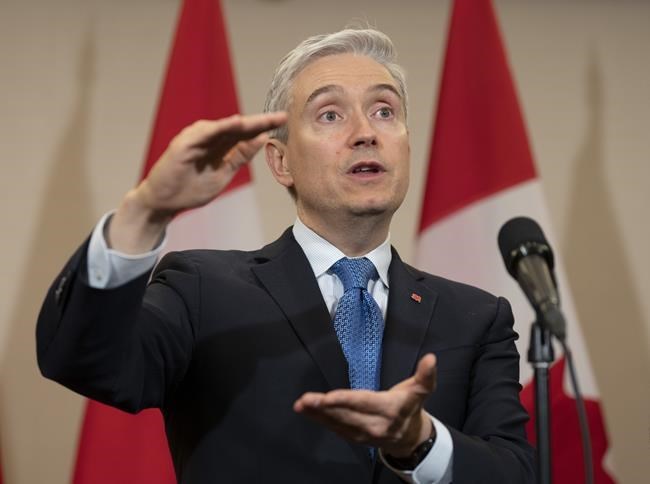OTTAWA — Canada offered Stellantis and LG Energy Solution a deal similar to the one Volkswagen accepted in March to build an electric-vehicle battery plant, but Ottawa wants Ontario to pony up a bigger share of the cash to make this deal happen, a federal minister said Tuesday.
Speaking from Seoul, South Korea, where he was participating in an economic security summit, Industry Minister François-Philippe Champagne said the Stellantis battery plant is a good investment for Canada.
But it's also a good investment for Ontario, he said, and the province needs to step up.
"I would say now what we need and the message to our colleagues in Ontario is, 'Pay your fair share and we will bring this stalemate, if you want, to a conclusion,'" he said.
Stellantis and LG announced in March 2022 that they were investing $5 billion to build a joint lithium-ion battery production factory in Windsor, Ont. It was to open next year, but Stellantis said Monday it had halted construction as Canada hadn't delivered on a "special contribution agreement" it said Canada promised last fall.
Ontario Premier Doug Ford said Monday his government had offered $500 million to Stellantis for capital costs — the same it offered to Volkswagen in March for its battery plant being built two hours down the road in St. Thomas. Ont.
He said Monday the federal government has to make good on the promises it made to the company.
"We'll go toe to toe with any state down in the United States," he said. "The only thing we can't do is go toe to toe with the U.S. federal government. That's the federal Canadian government's job, and they can do it."
Canada also offered Stellantis $500 million for capital costs initially, but Champagne said Monday that deal was agreed to months before the United States signed its Inflation Reduction Act into law.
That act, signed into law in August, provides $35 in production tax credits for every kilowatt hour of batteries produced. On Stellantis's Fiat New 500 electric vehicle, now the best selling EV in Europe, that amounts to about $3,000 in tax credits.
"So the company asked us to come back to the table and said, 'You know, minister, in light of those new circumstances, we should really sit down and try to see what we can do in order to to make sure that we are competitive in the North American market,'" Champagne said.
"And in the spirit of fairness, we said we would be."
Stellantis and LG jointly wrote to Prime Minister Justin Trudeau April 19 — about a month after Volkswagen said it had secured a deal to set up in Canada and one day before the size of the subsidies offered to Volkswagen were made public.
"We have seen the Canadian government make major announcements in the last month with other automotive manufacturers, while the Special Contribution Agreement remains unsigned," wrote Stellantis CEO Carlos Tavares and LG Energy Solution CEO Young Soo Kwon, in a letter obtained by The Canadian Press.
Stellantis and LG wanted Canada to seal the deal on an agreement that the companies said was finalized in February.
"In the event our agreement is not promptly executived, we will be forced to make difficult decisions regarding this project and other respective investments in Canada in order to deliver on our commitments to bring new technology to the North American market."
For Volkswagen, Canada offered a $700-million capital contribution and $8 billion to $13 billion in production subsidies for the batteries it makes over the first decade, to match what the company would get in production tax credits under the Inflation Reduction Act.
That contract includes a provision that if for any reason the IRA subsidies are reduced or eliminated before the end of Canada's deal with Volkswagen, the production subsidies provided by the government will similarly be reduced or eliminated
Nobody has specifically said yet what the equivalent IRA subsidy would be for Stellantis. Its plant is about half the size of Volkswagen's, with a production capacity of 45 gigawatt hours annually or enough to power about half a million Fiat New 500s. The Volkswagen plant is to eventually produce 90 gigawatt hours every year, or enough to power about one million electric vehicles.
That means the subsidies for Stellantis likely wouldn't add up to as much as those in the Volkswagen deal. Champagne said only the deal offered to Stellantis is "a fair deal quite similar to what we have offered to Volkswagen."
Ontario did not contribute to the production subsidies in the Volkswagen deal, but sometime over the winter, Canada asked Ontario to contribute more than just capital money for Stellantis.
Champagne said that when Canada agreed to renegotiate with Stellantis, "we did that with the understanding that as we have always done with our friends in Ontario, that we would be together."
Finance Minister Chrystia Freeland would not say how much Canada had offered Stellantis itself because "it's never a good idea to negotiate in public," nor would she explain why Ontario is being asked to contribute more.
"I'm not going to negotiate in public on the specifics, but we are very clear that Ontario needs to contribute its fair share," she said.
Both she and Champagne are adamant that Ontario stands to benefit the most from the two plants — Stellantis is promising to create up to 2,500 jobs and Volkswagen up to 3,000 — and it should contribute more money.
Freeland repeated that provinces should be making such contributions during a House of Commons finance committee meeting Tuesday, after she was asked by a Bloc Québécois MP about when Quebec will get its fair share of Canada's investments in clean technology.
This report by The Canadian Press was first published May 16, 2023.
— With files from Allison Jones and Liam Casey in Toronto.
Mia Rabson, The Canadian Press

